美术学专业:《解剖学》课程书籍文献(课外)Vilppu绘画圣经——绘制衣服的褶皱 Vilppu Drawing Drapery The Clothed Figure
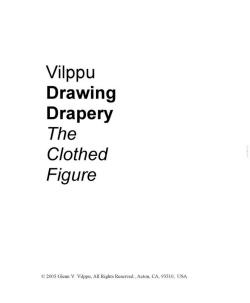
Vilppu Drawing Drapery The Clothed Figure 2005 Glenn V. Vilppu, All Rights Reserved., Acton, CA, 93510, USA
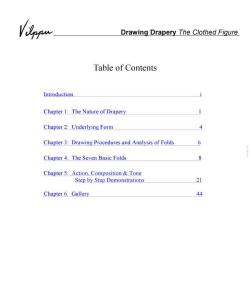
Drawing Drapery The Clothed Figure Table of Contents Introduction Chapter1:The Nature of Drapery Chapter 2:Underlying Form Chapter 3:Drawing Procedures and Analysis of Folds 6 Chapter 4:The Seven Basic Folds Chapter 5:Action,Composition Tone Step by Step Demonstrations 21 Chapter 6.Gallery 44
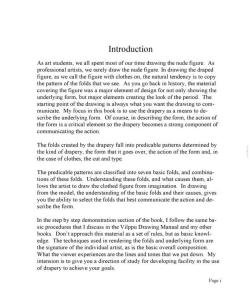
Introduction As art students,we all spent most of our time drawing the nude figure.As professional artists,we rarely draw the nude figure.In drawing the draped figure,as we call the figure with clothes on,the natural tendency is to copy the pattern of the folds that we see.As you go back in history,the material covering the figure was a major element of design for not only showing the underlying form,but major elements creating the look of the period.The starting point of the drawing is always what you want the drawing to com- municate.My focus in this book is to use the drapery as a means to de- scribe the underlying form.Of course,in describing the form,the action of the form is a critical element so the drapery becomes a strong component of communicating the action. The folds created by the drapery fall into predicable patterns determined by the kind of drapery,the form that it goes over,the action of the form and,in the case of clothes,the cut and type. The predicable patterns are classified into seven basic folds,and combina- tions of these folds.Understanding these folds,and what causes them,al- lows the artist to draw the clothed figure from imagination.In drawing from the model,the understanding of the basic folds and their causes,gives you the ability to select the folds that best communicate the action and de- scribe the form. In the step by step demonstration section of the book,I follow the same ba- sic procedures that I discuss in the Vilppu Drawing Manual and my other books.Don't approach this material as a set of rules,but as basic knowl- edge.The techniques used in rendering the folds and underlying form are the signature of the individual artist,as is the basic overall composition. What the viewer experiences are the lines and tones that we put down.My intension is to give you a direction of study for developing facility in the use of drapery to achieve your goals. Pagei
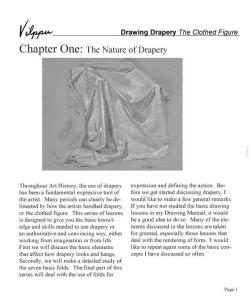
Drawing Drapery The Clothed Figure Chapter One:The Nature of Drapery Throughout Art History,the use of drapery expression and defining the action.Be- has been a fundamental expressive tool of fore we get started discussing drapery,I the artist.Many periods can clearly be de- would like to make a few general remarks lineated by how the artists handled drapery, If you have not studied the basic drawing or the clothed figure.This series of lessons lessons in my Drawing Manual,it would is designed to give you the basic knowl- be a good idea to do so.Many of the ele- edge and skills needed to use drapery in ments discussed in the lessons are taken an authoritative and convincing way,either for granted,especially those lessons that working from imagination or from life. deal with the rendering of form.I would First we will discuss the basic elements like to repeat again some of the basic con- that affect how drapery looks and hangs. cepts I have discussed so often. Secondly,we will make a detailed study of the seven basic folds.The final part of this series will deal with the use of folds for
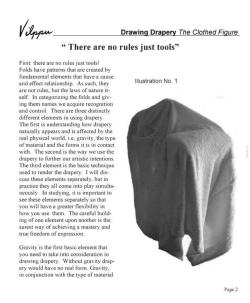
Drawing Drapery The Clothed Figure “There are no rules just tools” First:there are no rules just tools! Folds have patterns that are created by fundamental elements that have a cause and effect relationship.As such,they Illustration No.1 are not rules,but the laws of nature it- self.In categorizing the folds and giv- ing them names we acquire recognition and control.There are three distinctly different elements in using drapery. The first is understanding how drapery naturally appears and is affected by the real physical world,i.e.gravity,the type of material and the forms it is in contact with.The second is the way we use the drapery to further our artistic intentions. The third element is the basic technique used to render the drapery.I will dis- cuss these elements separately,but in practice they all come into play simulta- neously.In studying,it is important to see these elements separately so that you will have a greater flexibility in how you use them.The careful build. ing of one element upon another is the surest way of achieving a mastery and true freedom of expression. Gravity is the first basic element that you need to take into consideration in drawing drapery.Without gravity drap- ery would have no real form.Gravity, in conjunction with the type of material Page2
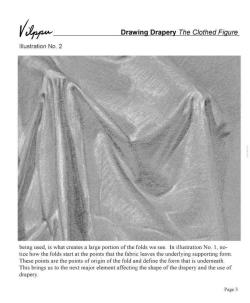
Virpw Drawing Drapery The Clothed Figure Illustration No.2 being used,is what creates a large portion of the folds we see.In illustration No.1,no- tice how the folds start at the points that the fabric leaves the underlying supporting form. These points are the points of origin of the fold and define the form that is underneath. This brings us to the next major element affecting the shape of the drapery and the use of drapery. Page 3

Drawing Drapery The Clothed Figure Chapter Two:Underlying Form One of the primary artistic uses of drapery is to define the form that is underneath it.The other is to modify the look of that form.In reality,we are not drawing drapery,but us- ing drapery to draw the figure.In Chapter One the main point was the way gravity de- termined the origin of the folds and how the origin defined the form underneath.You cannot use drapery to define the form if you do not understand the form underneath the drapery.Our first step in drawing the drap- ery is to clearly define the underlying form. In looking at Illustrations No.3 and 4 notice how the folds act as lines going over and around the underlying figure.In Illustration No.4,even though only the drapery has been drawn,you get a clear understanding of the underlying form.The first five chap- ters of my Drawing Manual are almost solely dedicated to using simple forms to lllustration No.3 create the figure.This is the fundamental approach to understanding the volume that we use the drapery to describe. Illustration No.4 Page 4
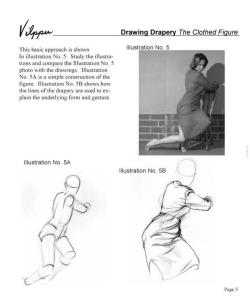
Drawing Drapery The Clothed Figure This basic approach is shown Illustration No.5 In illustration No.5.Study the illustra- tions and compare the Illustration No.5 photo with the drawings.Illustration No.5A is a simple construction of the figure.Illustration No.5B shows how the lines of the drapery are used to ex- plain the underlying form and gesture lllustration No.5A lllustration No.5B
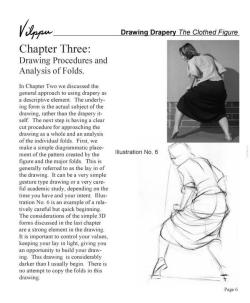
Drawing Drapery The Clothed Figure Chapter Three: Drawing Procedures and Analysis of Folds. In Chapter Two we discussed the general approach to using drapery as a descriptive element.The underly- ing form is the actual subject of the drawing,rather than the drapery it- self.The next step is having a clear cut procedure for approaching the drawing as a whole and an analysis of the individual folds.First,we make a simple diagrammatic place- ment of the pattern created by the Illustration No.6 figure and the major folds.This is generally referred to as the lay in of the drawing.It can be a very simple gesture type drawing or a very care- ful academic study,depending on the time you have and your intent.Illus- tration No.6 is an example of a rela tively careful but quick beginning. The considerations of the simple 3D forms discussed in the last chapter are a strong element in the drawing It is important to control your values, keeping your lay in light,giving you an opportunity to build your draw- ing.This drawing is considerably darker than I usually begin.There is no attempt to copy the folds in this drawing. Page6
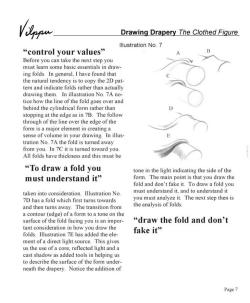
Drawing Drapery The Clothed Figure lllustration No.7 “control your values'” Before you can take the next step you must learn some basic essentials in draw. ing folds.In general,I have found that the natural tendency is to copy the 2D pat- tern and indicate folds rather than actually drawing them.In illustration No.7A no- tice how the line of the fold goes over and behind the cylindrical form rather than stopping at the edge as in 7B.The follow through of the line over the edge of the form is a major element in creating a sense of volume in your drawing.In illus- tration No.7A the fold is turned away from you.In 7C it is turned toward you. All folds have thickness and this must be “To draw a fold you tone in the light indicating the side of the must understand it" form.The main point is that you draw the fold and don't fake it.To draw a fold you taken into consideration.Illustration No must understand it,and to understand it 7D has a fold which first turns towards you must analyze it.The next step then is and then turns away.The transition from the analysis of folds. a contour (edge)of a form to a tone on the surface of the fold facing you is an impor- "draw the fold and don't tant consideration in how you draw the folds.Illustration 7E has added the ele- fake it'” ment of a direct light source.This gives us the use of a core,reflected light and a cast shadow as added tools in helping us to describe the surface of the form under- neath the drapery.Notice the addition of Page 7
按次数下载不扣除下载券;
注册用户24小时内重复下载只扣除一次;
顺序:VIP每日次数-->可用次数-->下载券;
- 美术学专业:《解剖学》课程书籍文献(课外)Vilppu绘画圣经——动物的绘制.pdf
- 美术学专业:《解剖学》课程书籍文献(课外)Vilppu绘画圣经——绘制手和脚 Drawing Feet Vilppu And Hands.pdf
- 美术学专业:《解剖学》课程书籍文献(课外)向大师学绘画艺用解剖(罗伯特·贝弗利·黑尔).pdf
- 美术学专业:《解剖学》课程书籍文献(课外)最全的人体肌肉图解(高清晰).pdf
- 美术学专业:《解剖学》课程书籍文献(课外)國外FORCE人体速写高级技法教程.pdf
- 美术学专业:《解剖学》课程书籍文献(课外)标准人体肌肉3D解剖图(Muscle System).pdf
- 美术学专业:《解剖学》课程书籍文献(课外)國外经典手部素描 肌肉结构 动作造型 详细教学.pdf
- 美术学专业:《解剖学》课程书籍文献(课外)國外教你用结构方法绘制动漫人物与动物.pdf
- 美术学专业:《解剖学》课程书籍文献(课外)国外人体动态结构素描详析 Burne Hogarth DYNAMIC FIGURE DRAWING.pdf
- 美术学专业:《解剖学》课程书籍文献(课外)国外人像素描详细教程 THE ART OF DRAWING Drawing Portraits FACES AND FIGURES GIOVANNI CIVARDI.pdf
- 美术学专业:《解剖学》课程书籍文献(课外)国外动漫人物动态结构绘画技巧教学.pdf
- 美术学专业:《解剖学》课程书籍文献(课外)西方绘画大师——卡拉瓦乔.pdf
- 美术学专业:《解剖学》课程书籍文献(课外)伯里曼着装形体结构.pdf
- 美术学专业:《解剖学》课程书籍文献(课外)艺用人体运动解剖学.pdf
- 美术学专业:《解剖学》课程书籍文献(课外)安格尔素描解析 INGRES INGRES SUMIAO JIEX.pdf
- 美术学专业:《解剖学》课程书籍文献(课外)伯里曼人体绘画技法.pdf
- 美术学专业:《解剖学》课程教学课件(PPT讲稿,图)躯干肌肉(新梳理)-2/2/1.ppt
- 美术学专业:《解剖学》课程教学资源(知识点)四肢主要知识点梳理.doc
- 美术学专业:《解剖学》课程教学课件(PPT讲稿,图)四肢肌肉重点梳理.ppt
- 美术学专业:《解剖学》课程教学课件(PPT讲稿,图)躯干肌肉(新梳理)-2/2/2.ppt
- 美术学专业:《解剖学》课程书籍文献(课外)Vilppu绘画圣经——绘制头部 Vilppu Head Drawing and Anatomy,Volume One,Glenn V. Vilppu.pdf
- 美术学专业:《解剖学》课程书籍文献(课外)Vilppu绘画圣经——人物画 Vilppu Figure Drawing Demonstrations Step-by-Step.pdf
- 美术学专业:《解剖学》课程书籍文献(课外)Vilppu绘画圣经——-人物组合 Vilppu's Mastering Composition.pdf
- 美术学专业:《解剖学》课程书籍文献(课外)Vilppu绘画圣经——绘制人物 The VILPPU DRAWING MANUAL.pdf
- 美术学专业:《解剖学》课程书籍文献(教学)英文 [向米开朗基罗学习人体绘画]Lessons.from.Michelangelo.pdf
- 美术学专业:《解剖学》课程书籍文献(教学)英文 人体解剖学Eliot_Goldfinger_-_Human_Anatomy_for_Artists.pdf
- 美术学专业:《解剖学》课程书籍文献(教学)英文 人体艺术绘画Art_Of_Drawing_The_Human_Body.pdf
- 美术学专业:《解剖学》课程书籍文献(教学)英文 艺用人体绘画解剖指南.pdf
- 美术学专业:《解剖学》课程书籍文献(教学)Artistic Anatomy for Digital Artists Scott Eaton’s.pdf
- 美术学专业:《解剖学》课程书籍文献(教学)Burne Hogarth - Dynamic Anatomy(Revised and Expanded).pdf
- 《声乐表演与实践》课程教学大纲(含声乐基础理论及欣赏).pdf
- 《声乐表演与实践》课程授课教案(石河子大学:刘希里).doc
- 《声乐表演与实践》课程教学资源(授课教案)声乐基础(二).doc
- 《声乐表演与实践》课程教学资源(授课教案)声乐表演(二).doc
- 《声乐表演与实践》课程教学资源(授课教案)闻声乐基础(二).doc
- 《声乐表演与实践》课程教学资源(授课教案)闻声乐表演(二).doc
- 《声乐表演与实践》课程教学资源(授课教案)闻声乐基础(四).doc
- 《声乐表演与实践》课程教学课件(PPT讲稿)合唱与指挥.ppt
- 《英文小说与电影》课程教学资源 English Novels and Films(自编资料,石河子大学:吴方敏、陈晨).doc
- 《英文小说与电影》课程授课教案(部分内容,共十二讲).docx
